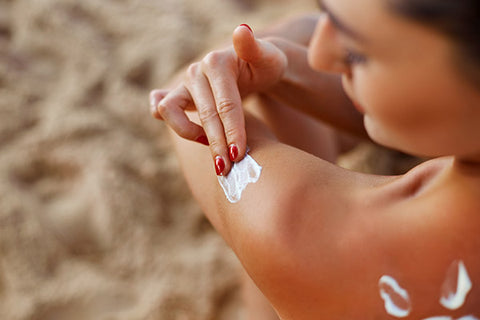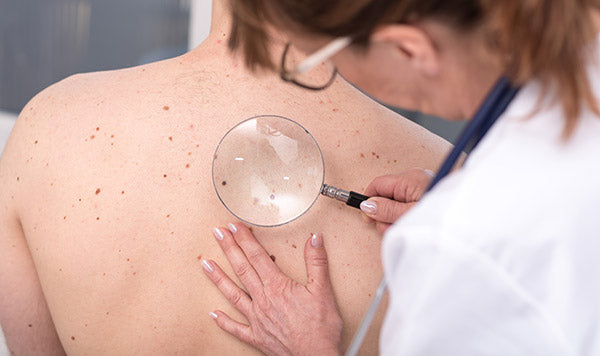Skin is your protective layer, but it needs protecting too. Skincare products can help protect your skin and fight daily damage.
While many things can cause or contribute to the development of skin cancer, exposure to ultraviolet (UV) rays are the most common cause. The sun emits UV rays that penetrate the atmosphere and skin tissue, where it breaks down collagen and the skin’s ability to heal.
The sun isn’t the only place you can get exposed to UV rays. Sun lamps and tanning beds, for example, emit UV rays to mimic the effects of sunlight. Limiting your sun exposure and protecting your skin is one of the best defenses against skin cancer.
Skin care tips to prevent skin cancer
While good skin care can’t guarantee that you won’t get skin cancer someday, it offers daily protection that reduces skin damage so your skin can stay as healthy as possible.
Wear sunblock every day (even in winter)

The face, head, and arms are the most common places to develop skin cancer because they get the most direct sunlight. Apply sunblock every day on any areas of the skin exposed to the sun.
Opt for a physical sunblock like SkinResourceMD’s Essential Solar Protector - Moisturizing Sunscreen. Physical sunblocks prevent UV rays from penetrating the skin, rather than absorbing the rays like chemical sunscreens. Our formula is also reef safe. We also offer a Hyaluronic Facial Solar Protector - Tinted Moisturizing Sunscreen. This formula moisturizes, helps prevent wrinkles, protects from the sun, and replaces foundation.
Avoid the sun from 10 am to 4 pm
The sun’s rays are at their most direct between 10 am and 4 pm. Fewer UV rays will penetrate the skin if you can stay inside or in the shade when UV rays are at their most direct. Spend time outside early in the morning or in the evening when the sun’s rays are less potent. You can add extra skin protection by wearing UV-protective clothing, too.
Protect your eyes and scalp

If you’re out in full sun, wear a hat to protect your scalp and eyes. For times when you’re not wearing a hat, make sure to apply sunscreen to your hairline and on your part.
A hat along with sunglasses can protect your eyes. Apply a gentle face sunscreen (both of SkinResourceMD’s sunscreens are gentle enough for the face) to protect the sensitive skin around your eyes.
Avoid getting sunburnt
This one is pretty obvious, but try to avoid getting sunburnt. Sunburns damage the skin, which can contribute to the development of skin cancer.
A key to keeping your skin burn-free is reapplying sunscreen. Swimming or sweating can remove sunscreen, so reapply every 60 to 80 minutes. For long days spent in the sun, reapply sunscreen every two hours regardless of whether you’re sweating or swimming to refresh your sunblock and keep that extra protective layer intact.
Examine your skin once a year

Skin cancer often starts with small spots. Take the time to get to know your skin by doing a close examination at least once a year. If you have any spots or moles that have changed or look questionable, call your doctor to see if you need to schedule an appointment.
Types of Skin Cancer
There are many types of skin cancer, but the three most common are:
- Basal cell carcinoma (BCC): BCC is the most common type of skin cancer and often develops in those with fairer skin, though people of all skin colors can develop it. It looks like a fleshy, round bump or pinkish area of skin.
- Squamous cell carcinoma (SCC): SCC looks like a scaly, firm bump or can appear as a sore that heals but then reappears. Again, people with lighter skin are more likely to develop it, but people of all skin colors can have SCC.
- Melanoma: Melanoma spreads the fastest of all skin cancers and is often known as the most serious type. This type of skin cancer develops within an existing mole or appears as a dark spot with an odd, uneven shape that may get larger with time.
Early detection is key for all types of skin cancers. If you have any areas of the skin that have changed over time, such as getting bigger, darker, or disappearing and reappearing, talk to your doctor.
The Skin Cancer Takeaway
Preventative measures like wearing UV-protective clothing, using sunblock, and avoiding the sun in the middle of the day are some of the best preventive measures against skin cancer. While it’s still possible to get skin cancer after taking preventative measures, your chances are much lower with daily protection. Take time to know your skin, and call your doctor to discuss any changes.


